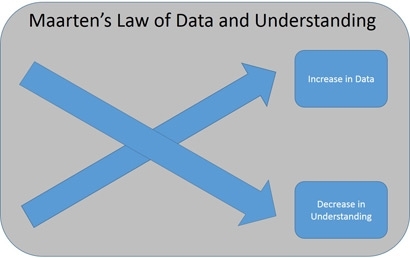Commentary
Why Big Marketing Data Does Not Help Marketing
- by Maarten Albarda , Featured Contributor, August 4, 2014
One thing is clear: My law on big marketing data still stands as much today as when I first published it in March of 2013. It reads: “As the amount of marketing data increases, the marketer’s understanding of all available data decreases at an equal rate.”

I hear from marketers all the time that they (we) live in an age when one month of Google advertising probably generates more data than all of the years of TV advertising since its inception. Yet marketers are more and more confused about how to interpret all that data and what to do as a result.
advertisement
advertisement
This is obviously a problem, because data is not only a source for insights, it is also a currency by which we calculate price, determine capability and ultimately determine value. Data could determine not only the value of a banner ad, an online video above the fold, or a TV spot -- but also the value of the people and tools that manage this whole process -- i.e, marketers and their agencies.
For decades we have accepted the GRP as our standard currency. Never mind that this currency was based on very thin data, using a simplistic formula of reach times frequency. If either of these two numbers were “soft,” the resulting GRP would obviously be soft, too. And the fact is, those two input numbers ARE soft. If you have seen the cover of Vogue or Wired, you now count as “reached” for all the ads in that magazine. If you had your TV on while the commercial appeared, you count as reached. It used to be that if you had your TV on during the 15 minutes in which ad breaks appeared, you counted as reached, but we have gotten a little more sophisticated. The TV rating is based on the viewing habits of just shy of 17,000 American Nielsen households (on a universe of over 117.5 million U.S. households).
Yet heaven forbid your agency under-delivers GRPs on your schedule. Make-goods and a media buying pitch are probably the immediate result.
In the new marketing economy, we are struggling with the fact that we do not have an adequate new currency. And that is why my law on big marketing data continues to stand. We have lots of data about lots of digital touch points, but have no common currency to make them comparable, or that allows us to make value calculations as we did with the GRP in the old marketing economy.
As a marketer, you are under constant pressure to deliver proof that the “marketing voodoo” contributed value to the company’s bottom line. Consequently, ambiguous or contradictory outcomes are unacceptable, because how can one determine if the plan contributed or not if there are no clear answers?
If there are numerous data sets, scattered across a multitude of dashboards that all say something, but not all point in the same direction, most marketers revert to the tried and trusted. They prefer incomplete but trusted “soft” data (GRPs) which they can sell internally, rather than a collection of data sets that are ambiguous and not understood.
Until we solve that problem, I fear my law will continue to stand.



P&G buys more big data than anybody, and that data reveals that it's time to dump at least half of their brands. The good news is, no one knows anything about those brands anyway. Besides, the local super market has A bargain-priced version that was made in the same joint as P&G's digital casualties.
Where I see first hand big data working for us is in the building of customer profiles and predictive models to target highly segmented audiences both offline (direct mail) and online (IP targeted display advertising)